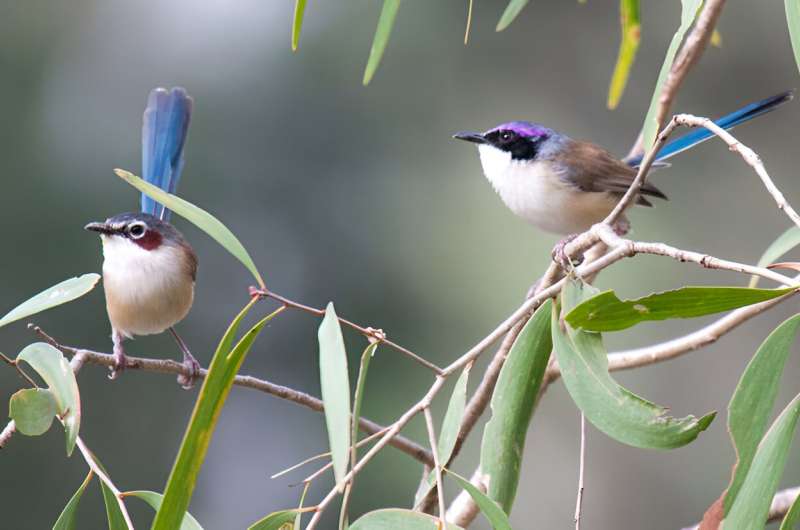This article has been reviewed according to Science X's editorial process and policies. Editors have highlighted the following attributes while ensuring the content's credibility:
fact-checked
peer-reviewed publication
trusted source
proofread
Scientists show how fires along waterways in Australia's tropical savanna threaten endangered birds
Fires in riparian zones within the tropical savannas of northern Australia affect the breeding success and survival of endangered, purple-crowned fairy-wrens.
Wildfires are becoming more common and more destructive as a result of climate change. Australian land managers in the highly flammable tropical monsoonal savannas often employ fire management as a strategy for conservation and carbon farming.
Large, destructive wildfires can be mitigated by deliberately introducing fire early in the dry season, when fires typically burn with low intensity.
Riparian zones are the interface between land and a river or stream. Although they are vitally important to biodiversity, the fire management approaches that best protect these areas are ill-understood.
According to a study published July 31 in the Journal of Applied Ecology riparian birds are highly sensitive to fire.
"Our study highlights the need for future research to improve our understanding impacts of riparian fire in the of savanna," said lead study author, Dr. Niki Teunissen, from the Monash University School of Biological Sciences.
"Riparian zones are home to an abundance of wildlife and serve as a passageway for animals to traverse the landscape and seek cooler climes," said Dr. Teunissen. "And they are quite vulnerable to fire."
The research team has been studying purple-crowned fairy-wrens at the Australian Wildlife Conservancy's Mornington Wildlife Sanctuary.
Purple-crowned fairy-wrens live in well-defined territories exclusively along rivers and creeks, rarely venturing out of the riparian zone.
"We've been studying this population of fairy-wrens for a long time, and by keeping track of individually marked birds, we've been able to gather a great deal of information about their survival and reproduction," said study author Professor Anne Peters, also from the School of Biological Sciences.
From 2011 through 2021, the research team studied purple-crowned fairy-wren density, survival, dispersal, and breeding success along 15 km of creek and river. With this data, they could compare the effects of low- and high-intensity fire in the early dry season on riparian vegetation and on the birds.
Dr. Teunissen said the fairy-wren population was impacted by fire for over 2.5 years, regardless of intensity. This was the case for low-intensity fire because reproductive success dropped during and immediately after the fire. For high-intensity fire, this was due to adult birds dying during the two to eight months after the fire (but not during the fire itself).
"The results of our study can be used to improve fire management strategies in tropical savannas, as purple-crowned fairy-wrens represent a biological indicator for riparian health," Dr. Teunissen said. "We urge fire managers and scientists to give greater consideration to the effects of fire on riparian habitat."
More information: Journal of Applied Ecology (2023).
Journal information: Journal of Applied Ecology
Provided by Monash University





















